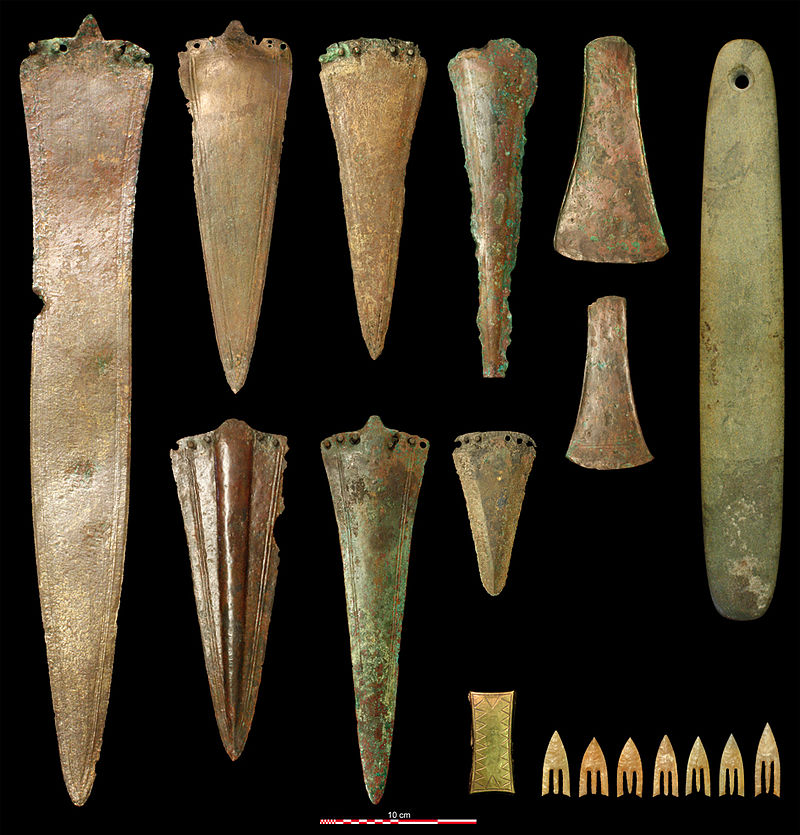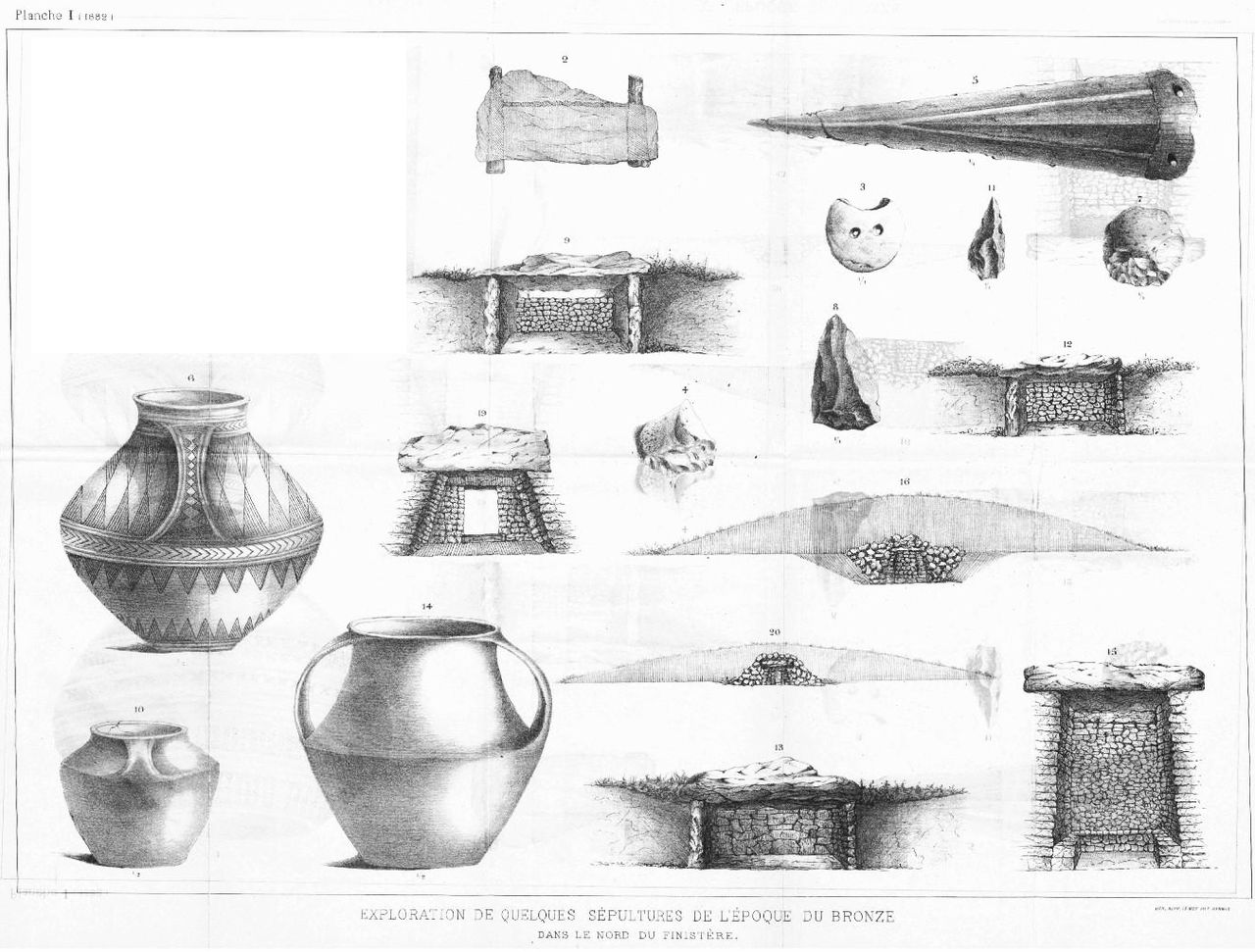Atlantic Bronze Age
———————————————————————————————————————————————————————————————————————————
The Atlantic Bronze Age is a cultural complex of the Bronze Age period in Prehistoric Europe of approximately 1300–700 BC that includes different cultures in Britain, France, Ireland, Portugal, and Spain.
Trade
The Atlantic Bronze Age is marked by economic and cultural exchange that led to the high degree of cultural similarity exhibited by the coastal communities from Central Portugal to Galicia, Armorica, Cornwall and Scotland, including the frequent use of stones as chevaux-de-frise, the establishment of cliff castles, or the domestic architecture sometimes characterized by the roundhouses. Commercial contacts extended from Sweden and Denmark to the Mediterranean. The period was defined by a number of distinct regional centres of metal production, unified by a regular maritime exchange of some of their products. The major centres were southern England and Ireland, north-western France, and western Iberia.
The items related to this culture are frequently found forming hoards, or they are deposited in ritual areas, usually watery contexts: rivers, lakes and bogs. Among the more noted items belonging to this cultural complex we can count the socketed and double ring bronze axes, sometimes buried forming large hoards in Brittany and Galicia; war gear, as lunate spearheads, V-notched shields, and a variety of bronze swords —among them carp's-tongue ones— usually found deposited in lakes, rivers or rocky outcrops; and the elites' feasting gear: articulated roasting spits, cauldrons, and flesh hooks, found from central Portugal to Scotland.
Armorican Tumulus Culture
The Armorican Tumulus culture is a Bronze Age culture, located in the western part of the Armorican peninsula of France. It is known through more than a thousand burial sites covered by a tumulus or otherwise. The culture is renowned for some exceptionally richly endowed burials of chieftains of the time, which are contemporary with the elite of the Wessex culture, in England, and the Unetice culture, in Central Europe.
The Armorican Tumuli refer to individual burials of the Bronze Age that can be covered by a tumulus in the western part of the Armorican peninsula of France, in a region commonly called Lower Brittany. Not all the tumuli of Brittany belong to the Armorican Tumulus culture. Older tumuli in the area date from the Neolithic period (e.g. the Saint-Michel tumulus) and later tumuli can also be found, dating to the Early Middle Ages (e.g. the Viking burial of Groix). Nevertheless there are more than a thousand Bronze Age tumuli in the region, many of them exceptionally richly endowed burials of chieftains of the time.
The Armorican Tumulus culture is characterised by a hierarchical society, with classic groups of burial mounds similar to the Wessex culture in Britain or Hilversum culture in Belgium. Settlements feature large houses, status symbols include daggers, halberds, and axes.

Funeral Practices
With the end of the Neolithic period, the use of collective megalithic burials (or dolmens) was abandoned in Brittany. During the Bell Beaker period, the development of individual burials may be observed, and this became widespread during the Early Bronze Age. The funerary architectures are varied, from the simple grave in a pit to the monumental tumulus measuring several tens of meters in diameter and several meters high (for example the tumuli of Kernonen and Saint-Fiacre). The grave can be made up of a cist made of edge slabs, dry stone walls or mixed walls (combining edge slabs and dry stones) or a wooden coffin. It can be covered by a cairn or a mound. Complete excavations of tumuli have shown that these monuments often have a complex history. Burials may have been added in the course of time, sometimes accompanied by an enlargement of the tumulus.
Despite the acidity of the soil in Brittany, more than a hundred skeletons, more or less well preserved, have been discovered in the Armorican tumuli. These burials are generally individual, but there are a few attested cases of double or triple even tombs. The bodies are most often found on their sides in a flexed position with the head to the east. They correspond to the remains of adults and children. The existence of young children buried in monumental tombs indicates the hereditary character of social status.
Material Culture
A strong social hierarchy is demonstrated through the funerary deposits: fine arrowheads, bronze weapons, gold artefacts, and exotic ornaments are largely reserved for the elite; bronze daggers and ceramics seem to distinguish a class of notables (heads of lineages or clans), while the majority did not deliver any grave goods that have been preserved.
The Armorican Tumulus culture are famous for their tombs of chiefs, richly endowed with prestigious goods deposited in wooden boxes. They deliver dozens of so-called Armorican arrowheads finely cut in blond flint from the Lower Turonian deposits of the Cher valley. They are undoubtedly the work of flint craftsmen and the symbol of the power of the chiefs of the time. Along with his arrows are bronze daggers and axes, the former being kept in leather scabbards and sometimes decorated with small gold studs (1 to 3 mm). One grave can accumulate up to ten daggers – beyond any measure in the rest of Western Europe in the Early Bronze Age. The daggers are of the Armorican type and generally decorated with meshes parallel to the edges and pierced with six rivet holes. More exceptionally, silver goblets, gold or silver chains, pendants and archer's armbands in amber, Whitby jet or gold and large stone sharpeners may be found in these graves.
Ceramics are never discovered in these chieftains' tombs. It is generally of biconical shape often associated with handles in variable number (1 to 6). It can be decorated with chevrons, hatched triangles and grooves.
In a few graves, located along the coast, ringed or biconical earthenware beads of British origin can be found. These pearls as well as the exotic ornaments bear witness to extensive exchange networks in Western Europe. The links were close with the elites of Wessex, whose graves yielded daggers of possible Breton origin (see for example the Bush Barrow).

Domestic Life
Several recent excavations have led to the discovery of settlements from the Early Bronze Age. On the island of Molène (Finistère), the house of Beg ar Loued shows the evolution of a dry stone construction between the end of the Bell Beaker culture and the Early Bronze Age. The people grew cereals (bare and dressed barley, emmer and wheat ) and legumes ( beans and peas), raised beef, pork, sheep (and perhaps goat) and practiced coastal fishing (collection of limpets on the foreshore and probably making use of fishing dams) but also hunting (grey seal, seabirds) . The practice of metallurgy is also attested in the form of a granite mold and copper beads. In Lannion (Côtes-d'Armor), two successive excavations by the National Institute for Preventive Archaeological Research ( INRAP ) led to the discovery of a monumental enclosure associated with two burial mounds from the Early Bronze Age and a network of plots into which a habitat was inserted during the Bronze Age 12.
The development of agricultural practices coupled with ore resources (notably the tin essential for the production of bronze) probably explains the boom in the culture of the Armorican Tumulus culture.